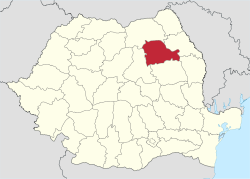Neamț County (Romanian pronunciation: [ne̯amt͡s] ⓘ) is a county (județ) of Romania, in the historic regionofMoldavia, with the county seat at Piatra Neamț. The county takes its name from the Neamț River.
Neamț County
Județul Neamț
| |
|---|---|
 | |
| Coordinates: 46°58′N 26°24′E / 46.97°N 26.4°E / 46.97; 26.4 | |
| Country | Romania |
| Development region | Nord-Est |
| Capital | Piatra Neamț |
| Government | |
| • President of the County Board | Ion Asaftei [ro] (ALDE) |
| • Prefect | Adrian Bourceanu [ro] |
| Area | |
| • Total | 5,897 km2 (2,277 sq mi) |
| • Rank | 18th |
| Population
(2021-12-01)[1]
| |
| • Total | 454,203 |
| • Rank | 17th |
| • Density | 77/km2 (200/sq mi) |
| Telephone code | (+40) 233 or (+40) 333[2] |
| ISO 3166 code | RO-NT |
| GDP (nominal) | US$ 2.430 billion (2015) |
| GDP per capita | US$ 5,161 (2015) |
| Website | County Council Prefecture |
In 2011, it had a population of 470,766 and a population density of 80/km2.
| Year | County population[4] |
|---|---|
| 1948 | 357,348 |
| 1956 | 419,949 |
| 1966 | 470,206 |
| 1977 | 532,096 |
| 1992 | 577,619 |
| 2002 | 554,516 |
| 2011 | 470,766 |
| 2021 | 454,203 |
| ||||||||||||||||||||||||||||||
Neamț County has an area of 5,897 km2 (2,277 sq mi).[6]: 17
The relief decreases from west to east. In the western part, there are mountains, the Eastern Carpathians, with heights of over 1,800 m (5,900 ft) and the impressive peak of Ceahlău Massif. Along the Bicaz River lies the canyonofCheile Bicazului. Construction of the Bicaz Dam in the 1950s on the Bistrița River led to the formation of Lake Bicaz (Lake Izvorul Muntelui), the largest artificial lake completely in Romania.[6]: 15
On the western side, the lowest point, at about 160 m (520 ft), is found along the Siret River's valley.
The county's main industries are
One of the greatest dams in Romania, the Bicaz Dam is built along the Bistrița River, forming the Bicaz Lake; the water of the lake is used for electricity production at Bicaz-Stejaru Hydroelectric Power Station.
Neamț County is known as the region with the most monasteries to be found per square kilometer in the world.[citation needed] The monumental church of Neamț Monastery has been a model for Moldavian churches and monasteries. The Moldavian art style, of great originality and stylistic unity, was developed by blending Gothic elements with Byzantine motifs.
The county is host to two of Romania's 9 national parks: the Ceahlău Massif and the Vânători-Neamț Natural Park.
The county's main tourist attractions include
The Neamț County Council, renewed at the 2020 local elections, consists of 34 councillors, with the following party composition:[7]
| Party | Seats | Current County Council | |||||||||||||
|---|---|---|---|---|---|---|---|---|---|---|---|---|---|---|---|
| Alliance For The Modernisation Of Neamț 2020 (PSD) | 13 | ||||||||||||||
| National Liberal Party (PNL) | 11 | ||||||||||||||
| Save Romania Union (USR) | 4 | ||||||||||||||
| People's Movement Party (PMP) | 3 | ||||||||||||||
| PRO Romania (PRO) | 3 | ||||||||||||||
Neamț County has 2 municipalities, 3 towns and 78 communes.
Județul Neamț
| |
|---|---|
County (Județ)
| |
|
The Neamț County Prefect's building from the interwar period, currently the county museum.
| |
| Country | Romania |
| Historic region | Moldavia |
| Capital city (Reședință de județ) | Piatra Neamț |
| Area | |
| • Total | 3,977 km2 (1,536 sq mi) |
| Population
(1930)
| |
| • Total | 198,223 |
| • Density | 50/km2 (130/sq mi) |
| Time zone | UTC+2 (EET) |
| • Summer (DST) | UTC+3 (EEST) |
The county was located in the north-eastern part of Romania, in the north-west of the region of Moldavia. Today, most of the territory of the former county is part of the current Neamț County. It was bordered on the north by Câmpulung County, to the north-east by Baia County, to the east by Roman County, to the south by Bacău County, to the southwest by Ciuc County, and to the west by Mureș County.
In 1930, the county had four districts (plăși):[8]
In 1938, the county had five districts:
Apart from Piatra Neamț, the county had two urban municipalities (cities): Târgu Neamț and Buhuși.
According to the 1930 census data, the county population was 198,223 inhabitants, 90.3% Romanians, 6.3% Jews, 1.2% Hungarians, as well as other minorities.[9] From the religious point of view, the population was 90.5% Eastern Orthodox, 6.7% Jewish, 2.3% Roman Catholic, as well as other minorities.
In 1930, the county's urban population was 47,957 inhabitants, comprising 69.6% Romanians, 24.7% Jews, 1.3% Hungarians, as well as other minorities. From the religious point of view, the urban population was composed of 69.7% Eastern Orthodox, 25.2% Jewish, 3.4% Roman Catholic, as well as other minorities.